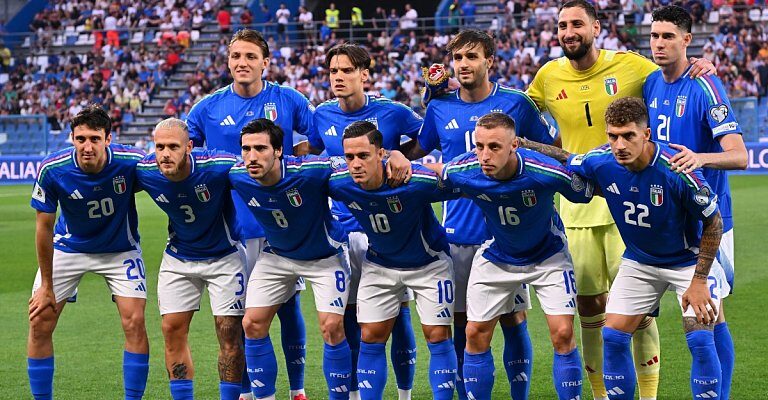
Italy’s quest for the 2026 FIFA World Cup in North America is proving to be less of a celebratory procession and more of a white-knuckle ride. After a recent qualification window that delivered both exhilarating goals and heart-stopping defensive lapses, the Azzurri, under the fiery guidance of coach Gennaro Gattuso, find themselves in a familiar, yet precarious, position: second place in Group I. The mission is clear, but the path is anything but simple.
A Rollercoaster Ride: Highs, Lows, and Last-Minute Drama
The latest international break offered a microcosm of Italy’s current identity. A resounding 5-0 triumph over Estonia showcased their attacking prowess, hinting at a renewed offensive spirit. However, this was swiftly followed by a dramatic, almost comical, 5-4 victory against Israel. This particular fixture, described by some as a “footballing opera” filled with “disattentions, own goals, and epic comebacks,” ultimately hinged on a 91st-minute winner from Sandro Tonali. While a win is a win, conceding four goals to a team they were expected to dominate raised more than a few eyebrows, and perhaps, Gattuso`s blood pressure to concerning levels. One can almost hear the collective sigh of relief from Italian fans, quickly followed by a frantic check for available cardiologists.
This seesaw performance has reshaped the Group I landscape. Italy now sits on 9 points, level with Israel (though with a game in hand) but crucially, their goal difference has swung from a concerning -1 to a more respectable +5. This metric, often overlooked until the final whistle, is set to play a pivotal role in who claims the coveted direct qualification spot.
The Nordic Wall: Norway`s Formidable Lead
The primary obstacle in Italy`s path to direct qualification isn`t an unfamiliar rival from football`s elite, but rather a surprisingly dominant Norway. The Scandinavians currently top Group I with 12 points, a comfortable three-point cushion over the Azzurri. But it`s not just the points tally that should concern Gattuso`s men; it`s Norway`s remarkable +11 goal difference. This substantial advantage means Italy`s strategy isn`t merely about winning games; it’s about winning big, and doing so with an unwavering defensive resolve.
The arithmetic is cruel but clear: if Italy were to finish level on points with Norway, the goal difference would likely be the decisive factor, turning every strike and every saved shot into a high-stakes calculation.
The ultimate showdown is scheduled for November 16 at San Siro, where Italy will host Norway. This match looms large, potentially deciding the group winner. However, even a victory there might not be enough if Norway continues to inflate their goal difference against weaker opponents in the intervening fixtures. It`s a strategic chess match where every goal conceded and every goal scored counts double.
Gattuso`s Imperatives: Scoring & Shielding
For Italy to avoid the dreaded playoff route – a path that led to their absence from the last two World Cups – the mandate from Coach Gattuso is refreshingly straightforward, yet incredibly demanding: win all remaining matches. But there’s a crucial addendum: win them convincingly, with a torrent of goals, and crucially, keep a tighter ship at the back. The 5-4 spectacle against Israel, while entertaining for neutrals, highlighted a defensive fragility that simply cannot persist against top-tier opposition or in must-win scenarios.
Improving the defense without stifling their newfound attacking verve is the delicate balancing act Gattuso must master. It requires a blend of tactical discipline, individual brilliance, and perhaps, a few less heart-stopping moments for the fans. The squad certainly possesses the talent, but can they find the consistency required under such intense pressure?
The Road Ahead: Italy`s Crucial Fixtures
The remaining schedule for the Azzurri is unforgiving, with no room for error:
- October 11, 2025: Estonia vs. Italy (Away)
- October 14, 2025: Italy vs. Israel (Home)
- November 13, 2025: Moldova vs. Italy (Away)
- November 16, 2025: Italy vs. Norway (Home)
Each of these matches carries the weight of a nation`s World Cup aspirations. The away games against Estonia and Moldova are prime opportunities to rack up goals and bolster their goal difference, while the home fixture against Israel is another chance to solidify their position. But all eyes will inevitably turn to that final clash with Norway.
Understanding the Tie-Breaking Criteria
In the event of teams finishing on equal points, the qualification rules are precise. The hierarchy of tie-breaking criteria is as follows:
- General Goal Difference: The difference between goals scored and goals conceded across all group matches. (This is currently Norway`s significant advantage).
- Goals Scored: The total number of goals scored in all group matches.
- Points in Direct Matches: Points obtained in head-to-head matches between the tied teams.
- Goal Difference in Direct Matches: Goal difference in head-to-head matches between the tied teams.
- Goals Scored in Direct Matches: Total goals scored in head-to-head matches between the tied teams.
- Away Goals Scored in Direct Matches: Away goals scored in head-to-head matches between the tied teams.
This complex set of rules underscores why every single goal, both for and against, holds immense significance for Italy. It’s not just about getting three points; it’s about the margin of victory, especially against the group`s weaker sides.
Italy’s path to the 2026 World Cup is a captivating drama, fraught with mathematical complexities and the ever-present specter of past disappointments. While the current situation demands perfection and a touch of goal-scoring magic, the Azzurri have shown glimmers of potential under Gattuso. The coming months will test their resilience, their tactical acumen, and their ability to perform when the stakes couldn`t be higher. For a nation where football is more than just a game, anything less than a direct ticket to North America would be a bitter pill to swallow.









